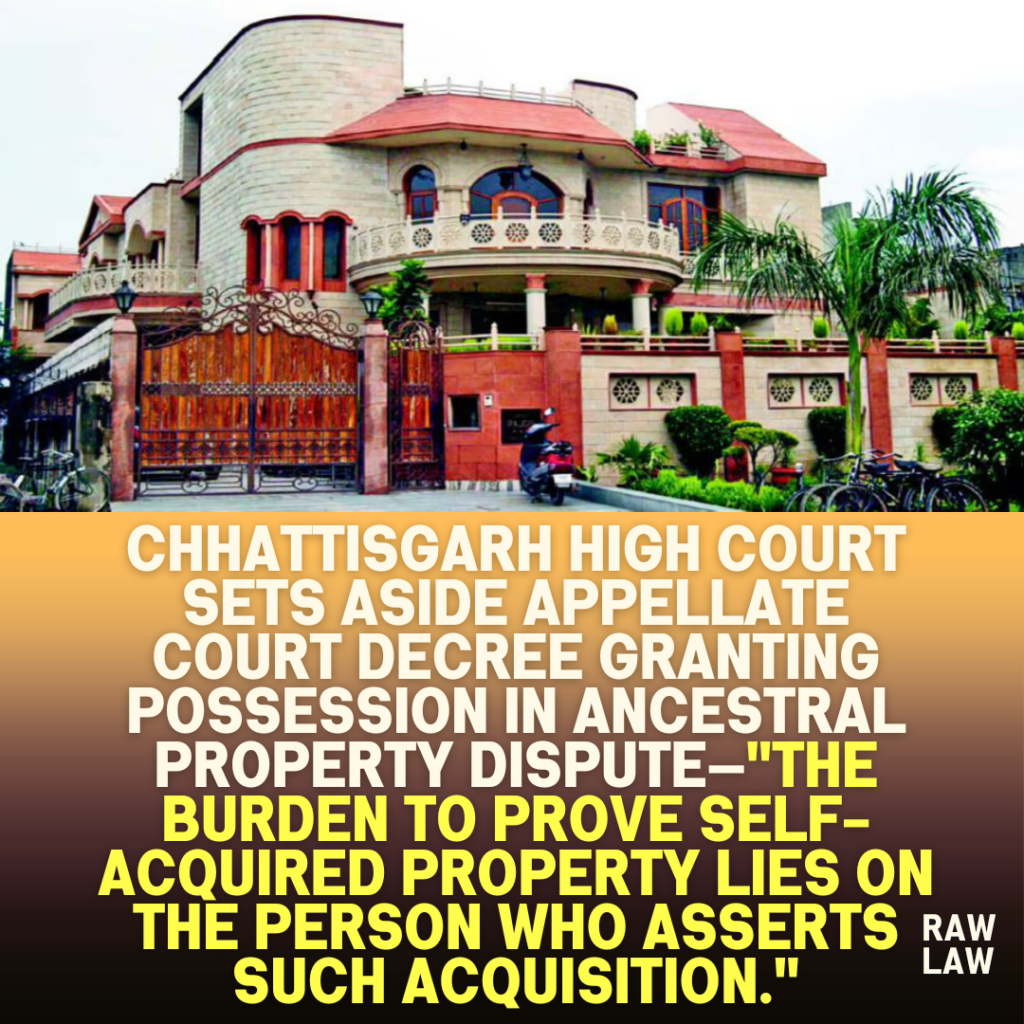Court’s Decision
The Chhattisgarh High Court, in SA No. 378 of 1992, allowed the second appeal preferred by the defendants and set aside the judgment and decree dated 08.08.1992 passed by the First Appellate Court. It restored the judgment of the Trial Court dated 22.01.1985, which had dismissed the plaintiffs’ suit for declaration of title, possession, and permanent injunction.
The Court held that the First Appellate Court’s finding that the plaintiffs’ father had acquired excess land through self-earning was perverse and unsupported by evidence. The Court also found that the plaintiffs had failed to plead or prove dispossession, and therefore, the suit was barred by limitation.
“The substantial question of law No. 1 and 3 framed by this Court are answered in favour of the defendants… no relief can be granted to the plaintiffs.”
Facts
The plaintiffs filed a suit seeking a declaration of title, permanent injunction, and possession of agricultural land described in the plaint’s Schedules C and D. They contended that their father, Ghadwa, and his brother, Baratia, had partitioned the ancestral land received from their father, Raghu, whereby Baratia received 20 acres and Ghadwa 36.70 acres. They alleged that Ghadwa, through his own earnings, later increased his holding to 52.80 acres, which was recorded in the name of his wife, Mangaldai.
After Mangaldai’s death, the plaintiffs claimed the defendants, who were relatives, manipulated revenue records with the help of revenue officers and wrongfully recorded their names, eventually initiating partition proceedings and receiving 1/8th share by order of the Tahsildar. This prompted the plaintiffs to file a civil suit asserting sole ownership over the land except for a portion described in Schedule D.
Issues
- Whether the First Appellate Court erred in holding that the land recorded in excess of the equal share allotted to the two brothers was self-acquired by the plaintiffs’ father, despite lack of pleadings or evidence?
- Whether the First Appellate Court wrongly granted a decree for possession without specifically identifying the land?
- Whether the suit was barred by limitation in the absence of specific pleading or proof of the date of dispossession?
Petitioners’ Arguments
The appellants/defendants argued that:
- The finding of self-acquisition was based on no pleadings or documentary proof such as sale deeds or lease documents, and hence was perverse.
- The Appellate Court erred in passing a possession decree without identifying specific land or providing Khasra numbers or date of dispossession.
- The plaintiffs failed to plead when they were dispossessed, making the suit barred by limitation under Article 64 of the Limitation Act.
- They relied on several Supreme Court judgments, including:
- Adiveppa & Ors. v. Bhimappa & Anr., (2017) 9 SCC 586
- Shyam Sundar Prasad v. Raj Pal Singh, (1995) 1 SCC 311
- Bachhaj Nahar v. Nilima Mandal, (2008) 17 SCC 491
Respondents’ Arguments
The plaintiffs/respondents contended:
- The Appellate Court had correctly relied on the documentary evidence, including Jamabandis (Ex P-1 to P-12), which demonstrated that partition between Ghadwa and Baratia had already taken place.
- They emphasized that even in applications under Order 39 Rule 1 & 2 CPC, the defendants had admitted the partition.
- They argued that the decree for possession was based on specific land descriptions in Schedule C and D, corroborated by revenue records like Ex P-6 (Jamabandi).
- They relied on Bechan Singh & Ors. v. Ramvati & Ors., SA No. 113 of 2020, decided on 17.12.2024.
Analysis of the Law
The High Court reiterated established principles:
- In Hindu law, there is a presumption of joint family property unless contrary is proved.
- The burden to prove self-acquired property lies on the person who asserts such acquisition.
- The suit must contain specific pleadings regarding dispossession to satisfy the limitation requirements under Article 64 of the Limitation Act.
Precedent Analysis
- Adiveppa & Ors. v. Bhimappa & Anr. (2017) 9 SCC 586: Reaffirmed that there is a presumption of joint family property, and burden of proof lies on the person asserting self-acquisition.
- Shyam Sundar Prasad v. Raj Pal Singh (1995) 1 SCC 311: Held that failure to plead and prove date of dispossession renders the suit barred by limitation.
- Bachhaj Nahar v. Nilima Mandal (2008) 17 SCC 491: Held that relief must flow from pleadings and cannot be granted based on assumptions.
- Bechan Singh v. Ramvati (2024 Chh HC): Cited by plaintiffs for arguing that absence of specific issues would not vitiate trial if evidence has been led.
Court’s Reasoning
- The Court found that the First Appellate Court erroneously reversed the burden of proof and presumed self-acquisition without concrete evidence.
- It noted contradictions in plaintiffs’ testimony, especially that their key witnesses were unaware of the partition or how the land increased.
- The Court found no credible evidence of dispossession, with vague pleadings about events post-1962 and no challenge to mutation entries made in the revenue records.
- Thus, the suit was barred by limitation and not maintainable.
Conclusion
The High Court allowed the second appeal and restored the judgment of the Trial Court which had dismissed the plaintiffs’ suit. It held:
“No relief can be granted to the plaintiffs.”
Implications
This judgment reaffirms the strict burden on plaintiffs to plead and prove self-acquisition in joint Hindu family property disputes. It emphasizes that relief cannot be granted in the absence of clear pleadings, credible evidence, and limitation compliance. Courts must not draw presumptions without foundational facts or documentary support.
Also Read: Gujarat High Court Quashes Preventive Detention of Alleged “Dangerous Person”



